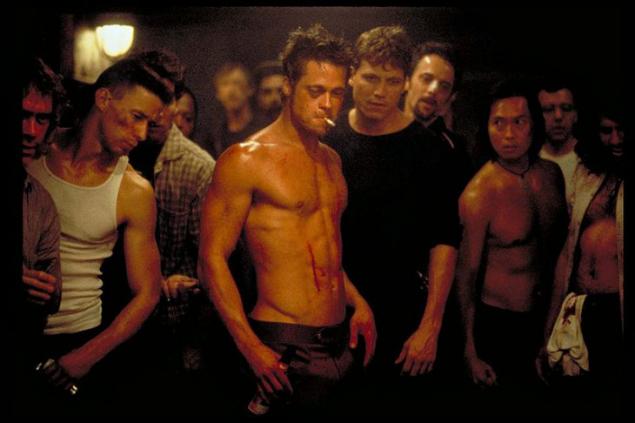149
10 Ideas From Books That Were Incarnated In Real Life
Sometimes, without knowing it, a writer becomes an oracle, accidentally predicting the appearance of a phenomenon or giving a name to a phenomenon that does not yet exist. Website He publishes a fascinating article from Bigpicch’s blog about a dozen book ideas that have been realized in reality over the years.
1. In "Generation P" by Victor Pelevin for the first time Russian kvass was opposed to Coca-Cola. After breeding two drinks in different corners of the ring, the brand “Nicola” was born and the slogan “Kvass is not cola, drink Nikola”. Subsequently, such a brand of kvass actually appeared on sale.
2. Chuck Palahniuk in his famous “Fight Club” organization of the same name became a place where people through honest fights splashed out their emotions. It's brilliant. The idea was so popular that after the release of the film adaptation, underground (and sometimes not) analogues of the club appeared in many cities of the world. Many of them still exist to this day.

Photo source: Bigpicture.ru3. Arthur Conan Doyle, in his stories about Sherlock Holmes, described many forensic techniques that were not yet known to the police. Among them are collecting cigarette butts and cigarette ash, identifying typewriters, looking into the magnifying glass of traces at the scene. Subsequently, the police began to use these and other methods of Holmes.
4. In Gogol’s Dead Souls, a brilliant criminal scheme is given. The main character bought what is not in fact, but what is on paper. Hence the modern practice of "left" orders to contractors, when money goes for work that is done only on documents.
5. The philosopher Friedrich Nietzsche in his work “Thus Spoke Zarathustra” outlined the idea of “superman”. According to this theory, people were not the ultimate achievement of nature, but only a guide to a higher race - a race of supermen. This idea was then actively developed by Adolf Hitler, who claimed that such a race was the Aryan.

6. In his book 20,000 Leagues Under the Sea, Jules Verne described a new type of ship: the submarine. At that time (1869), the idea of a deep ship was just emerging, and the Nautilus became the epitome of technological progress. His name became the most popular among submarines. Verne is known as the father of submarines. In honor of "Nautilus", by the way, still called electronic devices, computers, spacecraft, as well as restaurants, hotels, rock bands and sports clubs.
7. In the utopia of Artem Senatorov and Oleg Logvinov “Ascetic Russia”, ordinary machines for replenishing an account on a mobile differed in original service. After entering the bill on the screen appeared an offer to play the game "even-odd". After winning, the amount contributed could be doubled. Loss led to loss of funds. So the children spent all their pocket money, the elderly — pension. In reality, this idea was really discussed, but after the legislative restriction in the country of gambling business quickly faded.
8. In the story of the Strugatsky brothers “Noon, XXII century” refers to the “Kasparo-Karpov system” – a method that was used to remove a “copy” of the brain and build its mathematical model. The work was published in 1962 - Anatoly Karpov was then only 11 years old, and Garry Kasparov was not yet born.

Rferl.org9. The term "atomic bomb" was first used by the writer Herbert Wells. It appeared in the pages of his work “The Liberated World”. Interestingly, the book was published in 1913, that is, before the First World War. As you know, the bomb itself was used only at the end of World War II, in 1945.
10. Ray Bradbury came up with the most popular headphone format today – the so-called “drops”. In the acclaimed book Fahrenheit 451, he wrote: “In her ears are tightly inserted miniature Shells, tiny, thimble radios, bushings, and an electronic ocean of sounds – music and voices, music and voices – waves wash the shores of her waking brain.” The novel was written in 1950, you know what headphones were at that time!
via bigpicture.ru ? p=336718
1. In "Generation P" by Victor Pelevin for the first time Russian kvass was opposed to Coca-Cola. After breeding two drinks in different corners of the ring, the brand “Nicola” was born and the slogan “Kvass is not cola, drink Nikola”. Subsequently, such a brand of kvass actually appeared on sale.
2. Chuck Palahniuk in his famous “Fight Club” organization of the same name became a place where people through honest fights splashed out their emotions. It's brilliant. The idea was so popular that after the release of the film adaptation, underground (and sometimes not) analogues of the club appeared in many cities of the world. Many of them still exist to this day.

Photo source: Bigpicture.ru3. Arthur Conan Doyle, in his stories about Sherlock Holmes, described many forensic techniques that were not yet known to the police. Among them are collecting cigarette butts and cigarette ash, identifying typewriters, looking into the magnifying glass of traces at the scene. Subsequently, the police began to use these and other methods of Holmes.
4. In Gogol’s Dead Souls, a brilliant criminal scheme is given. The main character bought what is not in fact, but what is on paper. Hence the modern practice of "left" orders to contractors, when money goes for work that is done only on documents.
5. The philosopher Friedrich Nietzsche in his work “Thus Spoke Zarathustra” outlined the idea of “superman”. According to this theory, people were not the ultimate achievement of nature, but only a guide to a higher race - a race of supermen. This idea was then actively developed by Adolf Hitler, who claimed that such a race was the Aryan.

6. In his book 20,000 Leagues Under the Sea, Jules Verne described a new type of ship: the submarine. At that time (1869), the idea of a deep ship was just emerging, and the Nautilus became the epitome of technological progress. His name became the most popular among submarines. Verne is known as the father of submarines. In honor of "Nautilus", by the way, still called electronic devices, computers, spacecraft, as well as restaurants, hotels, rock bands and sports clubs.
7. In the utopia of Artem Senatorov and Oleg Logvinov “Ascetic Russia”, ordinary machines for replenishing an account on a mobile differed in original service. After entering the bill on the screen appeared an offer to play the game "even-odd". After winning, the amount contributed could be doubled. Loss led to loss of funds. So the children spent all their pocket money, the elderly — pension. In reality, this idea was really discussed, but after the legislative restriction in the country of gambling business quickly faded.
8. In the story of the Strugatsky brothers “Noon, XXII century” refers to the “Kasparo-Karpov system” – a method that was used to remove a “copy” of the brain and build its mathematical model. The work was published in 1962 - Anatoly Karpov was then only 11 years old, and Garry Kasparov was not yet born.

Rferl.org9. The term "atomic bomb" was first used by the writer Herbert Wells. It appeared in the pages of his work “The Liberated World”. Interestingly, the book was published in 1913, that is, before the First World War. As you know, the bomb itself was used only at the end of World War II, in 1945.
10. Ray Bradbury came up with the most popular headphone format today – the so-called “drops”. In the acclaimed book Fahrenheit 451, he wrote: “In her ears are tightly inserted miniature Shells, tiny, thimble radios, bushings, and an electronic ocean of sounds – music and voices, music and voices – waves wash the shores of her waking brain.” The novel was written in 1950, you know what headphones were at that time!
via bigpicture.ru ? p=336718
20 autumn images for every occasion for different types of shapes
"Normal" crush in the Tokyo subway: such trash you've ever seen!
























